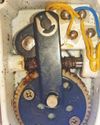Propeller care
Practical Boat Owner
|May 2025
Stu Davies has valuable tips on how to maintain your prop-and explains how this vital bit of kit works
-

The next time your boat is on the hard for a scrub, antifoul or whatever, have a look around and you will see quite a lot of different propellers on your neighbours’ boats.
Made of aluminium, brass or bronze – even plastic in the case of small outboards – some have two blades, some have three and some, very occasionally, have four.
While most propellers have fixed blades some have blades that fold.
Propellers can be right-handed, where they turn clockwise as you go ahead, or left-handed where they turn anti-clockwise to go ahead. Look from the stern to determine your rotation; mine is left-handed.
 These differences come about because different types of propellers are suited to different types of boats, engines and transmissions.
These differences come about because different types of propellers are suited to different types of boats, engines and transmissions.How it works
How a propeller works is quite complex. It transforms 'torque' from the engine into a linear motion. A boat's propeller is often referred to as a 'screw' but it is far from it.
It 'screws' its way through the water because the blades work similar to a wing on an aircraft and like a torque converter in a car's automatic transmission; once it is up to speed it almost actually has a positive 'grip' on the water.
A turning propeller moves water behind the blades, almost like a hand grabbing water and pushing it behind it. This produces part of the thrust.
Each blade has a distinctive curved shape which, as it turns, acts like a foil in the process 'pulling' the propeller and the boat forward.
It acts like a foil because the angle of the blade creates lift as it moves through the water, in a similar way that a wing creates lift through the air, with a positive pressure, on the underside and a negative pressure, on the top side.
यह कहानी Practical Boat Owner के May 2025 संस्करण से ली गई है।
हजारों चुनिंदा प्रीमियम कहानियों और 10,000 से अधिक पत्रिकाओं और समाचार पत्रों तक पहुंचने के लिए मैगज़्टर गोल्ड की सदस्यता लें।
क्या आप पहले से ही ग्राहक हैं? साइन इन करें
Practical Boat Owner से और कहानियाँ

Practical Boat Owner
An adventure to St Kilda
Marsali Taylor swaps skippering her Offshore 8m for being crew on a converted herring drifter, with comfy berths in the former fish hold
8 mins
January 2026

Practical Boat Owner
Mast refit and upgrade
Nicholas Koligiannis explains how he improved the mast on his Albin Ballad
5 mins
January 2026

Practical Boat Owner
Making more noise in fog
Nick Tyler takes the guesswork out of broadcasting fog signals
3 mins
January 2026

Practical Boat Owner
Solo across the Pacific
Triple amputee Craig Wood sailed into the history books with a non-stop, 90-day, 7,506-mile unassisted voyage
8 mins
January 2026
Practical Boat Owner
Al-assisted Shipping Forecasts
The Met Office has released new data showing a decade of steady improvement in the UK Shipping Forecast, with wind speed and sea state accuracy up by 10% or more.
1 min
January 2026

Practical Boat Owner
Bligh-ted reputation
Making the case for the mutiny on the Bounty's much maligned Captain Bligh
3 mins
January 2026

Practical Boat Owner
Wiper motor repair
Richard Stone mends his deck saloon windscreen wipers
2 mins
January 2026

Practical Boat Owner
'Let someone know boat plans' says report into fatal man overboard incident
The importance of designating a shore contact before setting off on a boat trip has been highlighted following a fatal man overboard incident near Inishbofin, Co. Galway, Ireland.
1 mins
January 2026

Practical Boat Owner
LITHIUM BATTERIES latest safety advice
Marine engineer and surveyor Marcus Jones unpicks the confusion surrounding the use of lithium batteries and what you should consider if installing them on board your boat
8 mins
January 2026

Practical Boat Owner
How to winterise your motor boat
Jon Mendez explains the steps you need to take to ensure your boat stays in top condition for next season
4 mins
January 2026
Listen
Translate
Change font size

